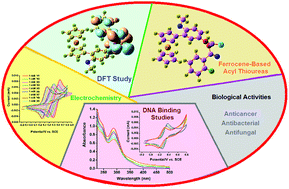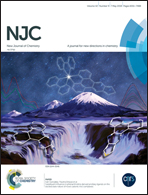Biologically active halo-substituted ferrocenyl thioureas: synthesis, spectroscopic characterization, and DFT calculations†
Abstract
In our search for new therapeutic agents, ferrocene-based thioureas (M1–M9) were successively synthesized and characterized by various analytical techniques like FT-IR, Raman, CHNS, AAS, and multinuclear (1H and 13C) NMR. The interaction of the compounds with DNA was investigated by electrochemical and spectroscopic measurements. These complexes exhibited impressive binding constants ranging from 9.75 × 103 to 5.71 × 104 M−1. The diffusion coefficients of the drug–DNA adducts are lower than that of the free drug indicating the formation of a high molecular weight complex that diffuses slowly towards the electrode. The cathodic peak potential shift in the cyclic voltammetric behavior of the synthesized complexes by the addition of DNA is attributable to the electrostatic interactions between the compound and DNA, an indicator of the oxidizable behavior of the compounds in the presence of the negative environment of DNA. The energies of the frontier molecular orbitals (EHOMO and ELUMO) and the Mulliken charge distribution on the optimized structures were determined using the DFT/B3LYP method combined with the 6-31G(d,p) basis set in DMSO. The theoretically calculated HOMO and LUMO energies (HOMO–LUMO band gap) based on the DFT study correlate well with the electrochemically determined redox potentials (electrochemical band gap), having a correlation coefficient of 0.953. The synthesized thioureas were preliminarily screened for their in vitro antimicrobial and cytotoxic activities. However, the most significant antitumor activity was found for M3 with an IC50 value of 1.87 μM. These compounds played a significant role in arresting microbial growth. The computational measurements were found to be in close agreement with the outcomes of biological activities.



 Please wait while we load your content...
Please wait while we load your content...